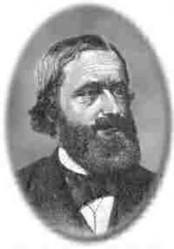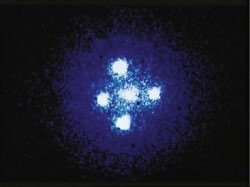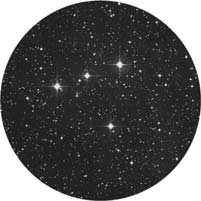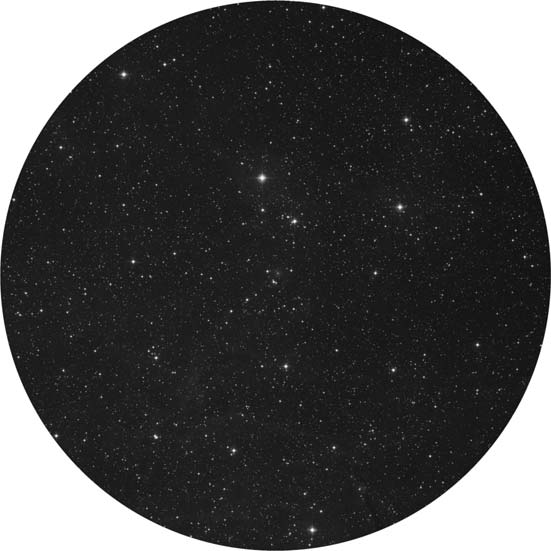Greetings, fellow SkyWatchers! If you’re a die-hard amateur astronomer, then you’ll recognize this as one of the prime times to undergo the rigorous “Messier Marathon” – an all night race to see how many Messier objects you can capture! If you need a bit of assistance, be sure to visit the Guide To Space section of Universe Today where you’ll find plenty of information to help you along with your quest. If you’re into a more quiet weekend, then come along as we discover some galactic star clusters that are a little bit more off the beaten path. Whenever you’re ready, I’ll see you in the backyard…
 March 12, 2010 – Today let’s celebrate three births! First comes Simon Newcomb. Born on this date in 1835, Newcomb was a Canadian–American astronomer who was really good with numbers. We have him to thank for ephemerides, those great tables of computed places of celestial bodies over long periods of time. Next is 1824 and Gustav Robert Kirchhoff, a physicist who established the theory of spectral analysis. Kirchhoff’s rule states: ‘‘When light passes through a gas, the gas absorbs the wavelengths it would emit if heated.’’ Kirchhoff was very knowledgeable in the field of electricity as well. In 1845, he proved current would flow at the speed of light in a zero resistance conductor. Last is Dorrit Hoffleit (b. 1906), the author of the Yale Bright Star Catalog. Dorrit enjoyed an 80-year career in astronomy and was one of the last living links to Annie Jump Cannon and the senior women’s astrophysics team at Harvard. In her 100-year life, Hoffleit certainly saw a lot of advances in astronomy!
March 12, 2010 – Today let’s celebrate three births! First comes Simon Newcomb. Born on this date in 1835, Newcomb was a Canadian–American astronomer who was really good with numbers. We have him to thank for ephemerides, those great tables of computed places of celestial bodies over long periods of time. Next is 1824 and Gustav Robert Kirchhoff, a physicist who established the theory of spectral analysis. Kirchhoff’s rule states: ‘‘When light passes through a gas, the gas absorbs the wavelengths it would emit if heated.’’ Kirchhoff was very knowledgeable in the field of electricity as well. In 1845, he proved current would flow at the speed of light in a zero resistance conductor. Last is Dorrit Hoffleit (b. 1906), the author of the Yale Bright Star Catalog. Dorrit enjoyed an 80-year career in astronomy and was one of the last living links to Annie Jump Cannon and the senior women’s astrophysics team at Harvard. In her 100-year life, Hoffleit certainly saw a lot of advances in astronomy!
While this is traditionally a “Messier Marathon Weekend”, tonight we’ll break with tradition and locate 6 Canis Minoris about three finger-widths northwest of Procyon. This normal K-type orange giant is around 560 light-years away from Earth, but aim a telescope its way for an opportunity to study an overlooked open cluster—Dolidze 26 (RA 07 30 06 Dec +11 54 00).
In the eyepiece, you’ll find a faint collection of stars that aren’t related to 6 Canis Minoris. Clusters of this type aren’t highly studied yet, but they belong to a group near in age and population and sharing similar star formation processes. Unlike other open clusters, these odd collections contain peculiar stars that produce very high velocity stellar winds and steady X-ray emission. Although it might not be as splashy as a Messier object, Dolidze 26 may very well accelerate cosmic ray particles!
March 13, 2010 – Today note the 1886 birth of Albert William Stevens, a daring balloonist who took the Explorer II to an altitude of 72,395 feet. He took the first photo showing Earth’s curvature and the first solar eclipse photo of the Moon’s shadow on Earth. Also, salute the 1855 birth on this date of Percival Lowell, who predicted the existence of Pluto (but Clyde Tombaugh was the one who actually discovered it, on Lowell’s 75th birthday!). Sir Percival was a determined soul who spent his life trying to find proof of life on Mars. He founded Lowell Observatory in 1894, where he studied Mars intensively, drawing the Red Planet covered with canals and oases. As Lowell once said: ‘‘Imagination is as vital to any advance in science as learning and precision are essential for starting points.’’
Tonight we’ll look at a bright collection of stars located less than a handspan west of Procyon. Its name is Collinder 106 (RA 06 37 19 Dec +05 57 55).
At a combined magnitude of 4.5, this expansive open cluster can be spotted as a hazy patch with the unaided eye and comes to full resolution with binoculars. It contains only around 14 members, but this widely scattered galactic collection has helped scientists determine size scales and dispersion among groups of its type. Viewed telescopically at low power, the observer will find it rich in background stars and a true delight in a low power, wide field eyepiece. If you’d like a challenge, hop a half degree to the northeast to spot Collinder 111 (RA 06 38 42 Dec +06 54 00). While visually only about one-tenth the apparent size of its larger southwestern neighbor, spare little Collinder 111 also belongs to the same class of open clusters. Who knows what may lurk around these understudied clusters?
March 14, 2010 – Celebrate today’s famous astro births, starting with astronaut Frank Borman (b. 1928), a crew member of Apollo 8, the first manned flight around the Moon. Next, astronaut Eugene Cernan (b. 1934), who floated in space for more than 2 hours during the Gemini 9 mission and piloted Apollo 10. How about Giovanni Schiaparelli (1835), the Italian astronomer who described Mars’s ‘‘canali’’ and named its ‘‘seas’’ and ‘‘continents.’’ Schiaparelli’s comet studies demonstrated that meteoroid swarms existed in the path of cometary orbits, and thus predicted annual meteor showers. He was first to suggest that Mercury and Venus rotate and discovered the asteroid Hesperia. Still not enough? Then wish a happy birthday to Albert Einstein (b. 1879), the German–American physicist considered the most brilliant intellect in human history!
 For a moment let’s reflect on Einstein’s Cross, proof of his genius. We can’t observe this Pegasus based gravitational lens right now, but we can try to understand Einstein’s theory of gravity as an effect of the curvature in space–time. For example, if you draw a line around the center of a ball, the line would be straight, eventually coming back to its point of origin. We don’t see the point until we reach it, but we know it’s there. Einstein knew this dimension existed and predicted any object with mass will bend space and time around it, just like our line around the ball. He predicted light would also follow a curved path around an object. . .such as a distant quasar located behind a closer galaxy!
For a moment let’s reflect on Einstein’s Cross, proof of his genius. We can’t observe this Pegasus based gravitational lens right now, but we can try to understand Einstein’s theory of gravity as an effect of the curvature in space–time. For example, if you draw a line around the center of a ball, the line would be straight, eventually coming back to its point of origin. We don’t see the point until we reach it, but we know it’s there. Einstein knew this dimension existed and predicted any object with mass will bend space and time around it, just like our line around the ball. He predicted light would also follow a curved path around an object. . .such as a distant quasar located behind a closer galaxy!
 Tonight’s object is a ‘‘cross’’ of stars that we’ll dub “Einstein’s Asterism”. Begin at Procyon and shift about 10 degrees southwest (or 2 degrees south of 18 Monocerotis) to locate this pretty grouping of stars. Yes it’s true. It’s just an unknown, undocumented, and unnamed asterism, but how fitting to honor all these famous astro figures and a brilliant man who once said: ‘‘The fairest thing in life we can experience is the mysterious. It. . .stands at the cradle of true art and true science.’’
Tonight’s object is a ‘‘cross’’ of stars that we’ll dub “Einstein’s Asterism”. Begin at Procyon and shift about 10 degrees southwest (or 2 degrees south of 18 Monocerotis) to locate this pretty grouping of stars. Yes it’s true. It’s just an unknown, undocumented, and unnamed asterism, but how fitting to honor all these famous astro figures and a brilliant man who once said: ‘‘The fairest thing in life we can experience is the mysterious. It. . .stands at the cradle of true art and true science.’’
Until next week, best of luck and clear skies to our marathoning friends!
This week’s awesome images are a historical collection of famous astronomers, “Einstein’s Cross” as imaged by the HST and provided by NASA, and all the great cluster images as done by Palomar Observatory, courtesy of Caltech. We thank you so much!




Rained out again here in No. Cal… dzzzz… been a long winter! Today’s best astronomy is done on the net.. SOHO shows a comet plunge~~~~~*
On the weekend sky watcher if their is a messier/ic/ngc designation for the objects listed could you please list them? I dont have a EQ mount on my scopes, 0ne is computer assist and the other is a go-to. with all of the city light it is hard for me to star hop.
Thanks